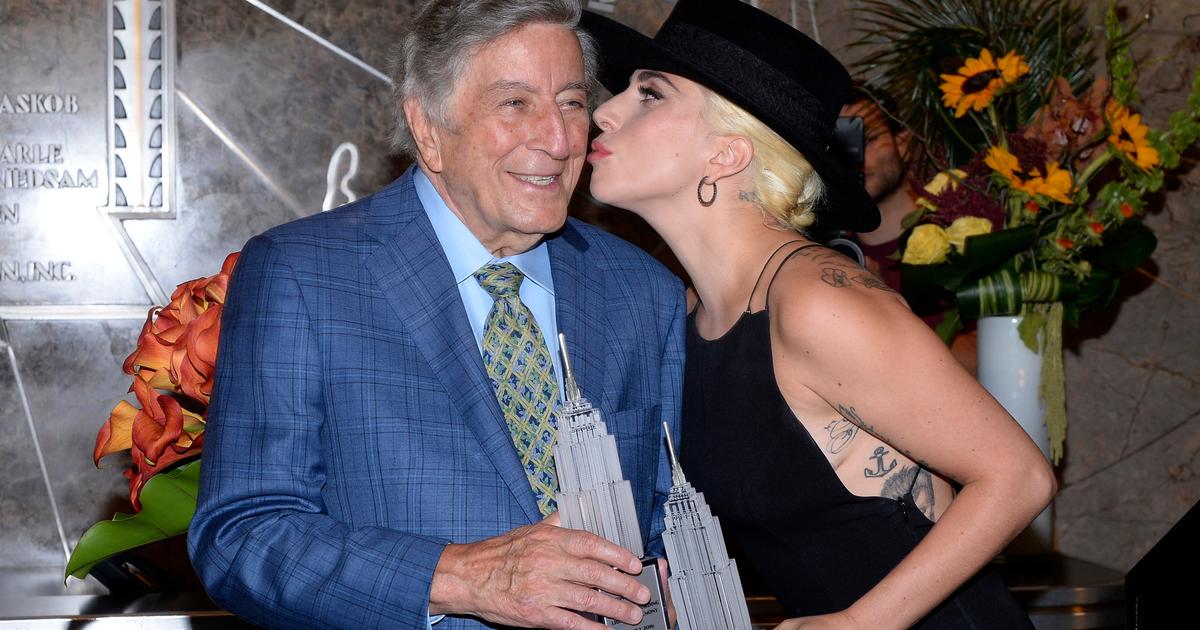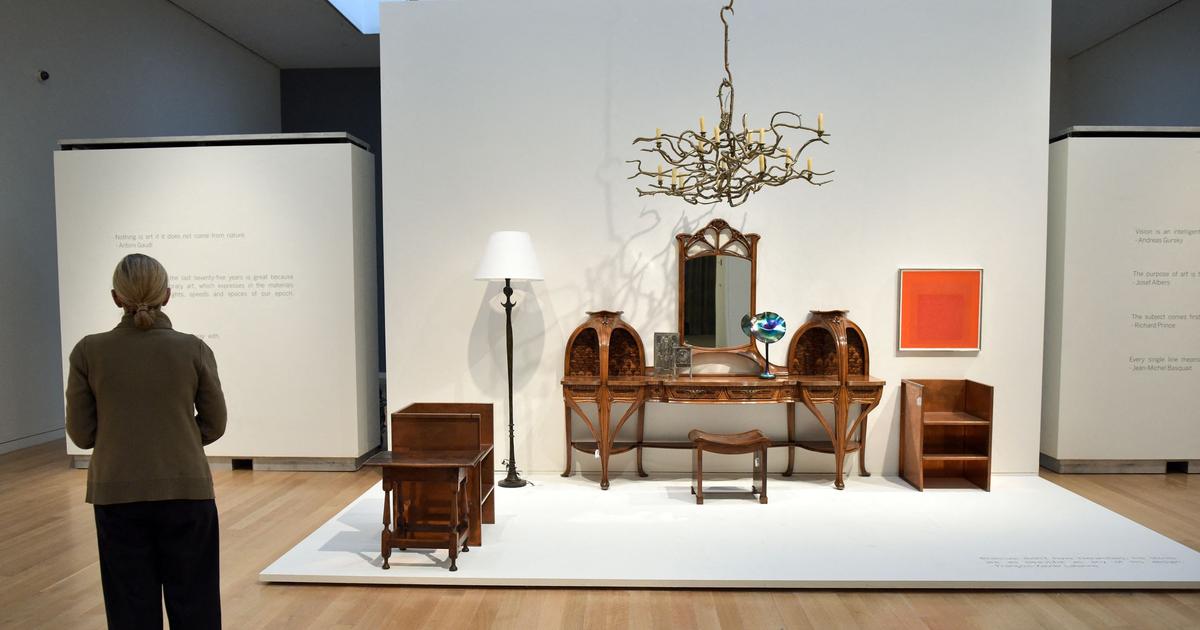An auction is a theatrical performance. A stage. Everything is possible. Until the cold stars fall from the sky. Imagine the scene. New York. In the evening sessions, the big bidding houses - especially Christie's and Sotheby's - present their best works. Those are only available to less than 1% of the world's population. They are usually crowded (now, following the times, guided by more auctioneers) and the public cheers, excited, when a price crosses the stratosphere. They don't applaud the quality of the work - just the money. It is as if in Maria Callas's time, viewers cheered her cache and ignored her extraordinary interpretation of
Tosca 's aria
Vissi d'Arte
(I lived by art)
.
This is the art market of the 21st century. A representation where Sotheby's sold 7,300 million dollars (6,450 million euros) during 2021, the highest figure in its 277-year history. With these numbers, its owner, the French-Israeli billionaire Patrick Drahi, would be studying - according to Bloomberg - to take the company back on the stock market. Maybe you need liquidity?
Forbes
magazine
estimates him a net worth of 7.6 billion. His great rival, Christie's, also filled the audience with stars. It entered 7.1 billion dollars (about 6.270 million). The best result in five years. Impossible without the 1.7 billion it raised in private sales. 12% more than in 2020 and 108% more than 2019.
Mozart, in the background, composes an overture to the capital of the 21st century. The libretto is by Piketty. Another house, Phillips, also broke its record by auctioning 1.2 billion dollars (1.06 billion) in luxury goods, 32% more than in 2019. It had never exceeded 1 billion. And Bonhams held 343 sessions. "An impressive increase from 310 in 2020," says Patrick Masson, managing director of the auction house in the UK and Europe. Because that year never existed. The art market has erased it from their memory, like a cream paste on charcoal. They soon forgot about the slumps in sales at Sotheby's (16%, to about $ 5 billion) and Christie's (25%, about $ 4.4 billion) in 2020. The famous resilience? No. The shameful inequity."High-end collectors are spending more than ever, and this is partly because the effects of wealth accumulation over the past two years have been very different from other crises," says economist Clare McAndrew. specialized in art. "One of the aftermath of
2009 financial crash
was the 30% drop in the number of billionaires and their net worth fell 45%.
But in 2020, millionaires increased 7% and wealth 32% ”.
Only 365 days were enough.
Christie's, Sotheby's and Phillips alone sold $ 15.6 billion (about € 13.8 billion) worth of art last year.
"We all dance to the sound of the oligarchs," laments collector Paco Cantos.
Revaluation
The
creation
of Michelangelo paints the extreme version of the inequality of the planet. How will the thousands of families waiting to receive the Minimum Living Income in Spain read these sentences? What does art paint in reality? Is it the endless praise of the Golden Calf? Yahweh said to Moses: "Do not make yourselves gods of silver or gold to put them next to me." It is the Exodus. The emerald glow of the dollar. José María Cano, a former member of the musical group Mecano, collector and painter, sold - according to the consultancy Artnet - last November at Christie's a
basquiat (The Guilt of Gold Teeth,
1982) for 40 million dollars. In 1998, he paid out just $ 387,500 to take the painting.
Blame the gold teeth
It is a large oil painting by an artist who placed a work worth $ 303.5 million in the first half of 2021. Only Picasso surpasses it.
“I have never seen the art market so strong.
Auction houses sell everything at prices much higher than estimated, especially African figurative art and art from its diaspora [creators who live in London, New York, Berlin, Brazil] ”, reflects by phone Jorge Pérez, one of the most Latino rich of the world, mega-collector and patron.
He has donated 12 works by 11 Latin American artists from his collection to the Reina Sofía and some 662,000 euros for the acquisition of pieces by Ibero-American creators (for now, five have been bought).
However, money pursues art, or vice versa. And it has its own particular geopolitics. The new geography flees from the heat of the sands of the United Arab Emirates or Saudi Arabia and is installed in the political turbulence of Hong Kong. Phillips, for example, is looking for a new space. The auction house sold 270 million dollars last year in the former English colony and Asia is the region that prospers the most. Nearby, Paris wants to defeat London by taking advantage of the financial, fiscal and legal turmoil that Brexit has caused. And the market grows by overlaying layers of business glaze. The basic primer is black artists and women lost in history. “Most of the high prices are in secondary markets which, by their nature, are unpredictable. But nevertheless,the impact on sales in the primary gallery is considerable and causes some to take advantage [by overproducing] of this upward trend ”, analyzes, by email, Kerry James Marshall, 66, the most expensive living African-American painter (21 , 1 million dollars for his fabric
Past Times
in 2018) of the world.
They are names that any collector remembers by heart, like a losing battle.
Amoako Boafo (1984), Toyin Ojih Odutola (1985), Adam Pendleton (1984), Jordan Casteel (1989), Kudzanai-Violet Hwami (1993), Aboudia (1983).
They are the artists of "excuses."
"There is a waiting list of more than a year";
"Museums and public foundations come first";
"The gallery's clients have priority."
And all the tricks that some gallery owners use in their theater with collectors.
Although they are creators of six figures.
Because liquidity rains for quite a few privileged people like tears of Saint Lawrence and there are plenty of buyers.
"The market is a living being and reacts to the trends of each moment", defends Alexandra Kindermann, Director of Communication at Christie's Europe.
Female stars also fall from that cold cosmos, attracted by the force of capital's gravity. Above all older women: Irma Blank (87 years old), Martha Jungwirth (81), Ida Applebroog (92) or Carmen Herrera, the 106-year-old Cuban artist, who exceeds a million dollars in the primary market. Too much pressure? “It does not exist, unless the success that everyone seeks is considered pressure. When you hit the jackpot, like a handful of female artists, jump on the wave and enjoy. Many will never go up, "advises Stefan Simchowitz, gallery owner and" polemicist "—the word by which he defines himself— based in Los Angeles. Women led Phillips' New York sales at his last November night shoot of 20th century and contemporary art. Works were auctioned for a total of 139.2 million dollars,96% of the lots. The best result that the house has achieved in its history in a single sale.
Thinking is the same as moving big secret trunks and it is difficult to find out what collectors think of what is happening in the market. 35% of millennials, according to Clare McAndrew, spent more than a million dollars on art in the first half of 2021. Perhaps their Calf is "now." That word (
Now
) is the one written on his cigarette case by the writer Raymond Carver (1938-1988) when cancer announced its beginning and its end.
All art are fragments of time.
Between the end of June 2020 and the same month of 2021 - in the contemporary segment - works valued at 2.7 billion dollars changed hands.
More than 100,000 pieces by some 34,600 artists.
Numbers -according to art- never seen before.
“The art market reflects exorbitant social differences (we thought the virus was going to reduce the gap), but the opposite happened, and this leads to it being far from showing the quality or importance that other works [far from fashions ] they will have a linear journey through artistic history ”, warns Argentine collector Aníbal Jozami.
Generational change
Maybe we see a mirage?
These two years of pandemic have accelerated virtual shopping, the incorporation of new markets, a generational change and unexpected trends.
“There is more demand for young figurative work that was not of interest until recently.
Hilary Pecis, Flora Yukhnovich, Jordan Casteel, Javier Calleja;
and they are only in their early thirties ”, explains collector Juan Bonet.
A first-time glaze on a very expensive fabric.
Amy Sherald (1973) - the artist who painted the official portrait of former first lady Michelle Obama - sold in December at Phillips
The Bather
's (2015) for $ 4.26 million.
It was 21 times its highest estimate ($ 200,000).
What a starter.
Portrait of former United States First Lady Michelle Obama by artist Amy Sherald Andrew Harnik (AP)
Tell us how to survive our madness
. It is the title of a book of short stories by Nobel Kenzaburo Oé. There is no such disease. Because collectors are the great believers. "It is very positive that the art world is expanding and diversifying," he observes by
e-mail.
Patricia Phelps de Cisneros, one of the world's leading collectors and patron. Only to the Reina Sofía he has donated 85 works by 45 artists and has 31 pieces in deposit. And he adds: “I am very happy to see more creators of new places participating in the system. Sometimes the private sector responds more quickly than the institutions; and collectors, in this sense, can be instrumental in collecting and appreciating works that the public system does not yet value. This is what happened with the art of Latin America a few years ago, and now it also happens with other productions ”. Without the generosity of Jorge Pérez (the photo of a donation from him,
Love at first sight
, by the Argentine Marta Minujín, announces the exhibition on the lights of the Paseo del Prado in Madrid) or by Patricia Phelps de Cisneros, for example, the new reorganization of the Reina Sofía Museum would have been impossible.
Latin effect
"There is a hunger for art, for (re) discovering and possessing," sums up the Parisian gallery owner Chantal Crousel. "In addition, the recent arrival of collecting from Latin America has given oxygen to the Spanish system, and that is good," admits curator Gabriel Pérez-Barreiro. But art and the market sometimes have a complex relationship, like a Max Planck equation; and others, on the other hand, as intuitive as a kiss between lovers. “Even if you sell it does not mean that it will go well for you, if you do not show paint or are black or a woman, it is more difficult; This must be said ”, warns Silvia Dauder, director of the Barcelona gallery ProjecteSD.
But with or without viruses, with or without new variants, with sales through the web, or with NFTs (
non-fungible
tokens
) shaking the
status quo
, the art market exhales fatigue. After decades of leadership, Malthus and Copernicus give up. Goodbye to the endless proliferation of fairs. Goodbye to being the center of sales. "Art fairs will continue to exist as social events, exchanges, social communication between collectors, entertainment.
Hubs
to see and be seen.
To meet new protagonists who are constantly emerging in the international artistic circle ”, predicts Elena Foster, editor, collector and founder of Ivorypress.
“But major sales - in most of the works exhibited at key fairs - have already been closed beforehand.
Via
or Zoom ”.
And ditch: "It is also happening with libraries."
Of course, the casino will remain open, the roulette wheel will spin and collectors will bet red or black, miss or pass against emerging young artists in a planetary competition.
"Some will be a good investment, some will not," predicts the all-powerful gallery owner Larry Gagosian in
Artnet
magazine.
. “For many people it is almost a speculation game. Get in soon. Get it cheap. It is the same as buying a lottery ticket. I don't like to sell art in this way. If you pay a million dollars, you are buying consensus ”. But there is a rush. The physical or digital Golden Calf shines with all the iridescence of the end of an era. In 2020 the art market generated 50,065 million dollars. During 2021 - experts - point to double-digit growth replicating the results of auction houses. However, speculation remains. “That the art system seems to be playing the casino when seeing how the fashions follow one another is a problem of the traditional media, not of the system. Things change fast and with it, the concerns of creators and intellectuals, formerly called art critics.We are many professionals who ignore these trends ", observes the commissioner Bartomeu Marí. However, an unknown Beeple got last March during an auction at Christie's $ 69 million for an NFT (
digital
collage
) titled
Everydays
:
The First 5,000 Days
or that houses accept cryptocurrencies when making payments announce the possibility of a change.
The worst enemy of romanticism is time and it doesn't matter what money looks like. Ungraspable or paper. Collectors around the world want painting and sculpture (31% of sales in the first half of 2021). The masks and social distance imposed by the pandemic have made them conservative. And rare is the top-tier gallery that doesn't promote young black painters or older artists. “There has always been a lot of noise in the market and we don't buy fashion artists. We are very cautious and we are very careful when it comes to acquiring work ”, admits Nimfa Bisbe, director of the La Caixa Foundation's Contemporary Art Collection. In my end is my beginning. Much of all this began in the 16th century, when Lorenzo de 'Medici was equally fond of Leonardo and his Spanish groom,able to stop a galloping horse with his hand.
Echoes of history
The difference between price and value has haunted art throughout its history.
It came a long time before the NFTs.
The most mundane luxury cost more than the best painting.
In 1613, for example, it is read in
The Triumph of Painting
(Editorial Nerea), by Jonathan Brown, Princess Elizabeth, daughter of James I and Anne of Denmark, wore a dress adorned with gold and silver lace. The lace alone was valued at £ 1,700, more than the best painting in the extraordinary collection of his brother Charles I. And the tapestries (who would say it today) cost more than the paintings. The Spanish Crown acquired in 1633 a series of six cloths with the story of Diana for 4,400 ducats. A manual worker earned 100 a year and a "Grande", with extensive properties, could receive 100,000 annually. But an important painting did not exceed 1,500. A work by Dürer was bought for 75 pounds and Murillo was more expensive than Velázquez. The passage of time is like death, you just stop waiting. The simplicity of existing.The Old Masters awaited the tolling of the decades with their legacy of works. The State paid 1.5 million euros in November for a small (67.5 × 42 centimeters)
El Greco's
Crucified Christ
that Sotheby's wanted to sell.
“The Grand Masters are still in good shape.
It is seen every time an important work appears at auction.
There are the 81 million euros paid in January by a
botticelli
[with attribution doubts].
The challenge is that these pieces are highly appreciated and nobody wants to let them go ”, points out Jordi Coll, the antique dealer who manages the possible
caravaggio
from Madrid. Maybe not everything is a problem of supply. Perhaps the old painters are out of focus in today's photographs. "Ancient art cannot be sold, as with contemporary art, over the internet", clarifies Nicolás Cortés, director of the gallery of the same name. And he says: "Customers want to see the painting and the dealer." Because it is a trust that takes a lifetime to earn. "Circles", "workshops", "schools", "vintage copies", "in the manner of", "false". Attributing a work takes decades of learning.
But let's imagine another function.
In 2019, the European Parliament published a 48-page report in which it concluded (the UK opposed) the need to abolish free ports.
Dull places, prisons for art - where taxes are not paid if the work is not removed - and prone to money laundering.
Let us dream that they are expropriated.
And a great museum is created by Unesco.
Surely, with these funds from thousands of works, the human being would be closer to answering two essential questions: who are we?
and where do we come from?
The other question: where are we going ?, looks bad.
'Ecce homo' attributed to Caravaggio.
Spain still does not exploit its treasure
The Spanish art market orbits the ragged edge of the universe. It barely reaches 1% of the total money that moves in the world. In the time of the dirty dust of the wake of dreams (2020) it totaled 308 million euros and during the days (2007) that preceded the financial crash it sparkled with the record of 427 million. These are the work data
The Spanish Art Market
in 202
1. Little for a country that has some of the most important museums and collections on the planet. Nothing for a land where an
Ecce homo
close to Caravaggio worth 250 million euros
can appear
. Something that happens once in a century. Spain should be a nation of collectors. It has wealth (very poorly distributed). It has a cultural industry. It has that flint gray of El Greco.
Some justify it by mixing legislation and taxation. "Countries with more restrictive import regulations will always be smaller and more domestically focused markets," explains Clare McAndrew, an art economist. And he adds: "The VAT tax on imports is almost double that of the French [6% of the world market] and export levies are a sure way for international collectors to avoid buying in Spain." The exemption from the taxation of art can be applied to contemporary works. But the history of art is the history of a robbery. And in this sense, Spain has been one of the most looted in Europe. Only Interpol is looking (as this newspaper reported) 723 stolen pieces. “If you knew the amount of art that came out of the 2008 crisis,especially of Andalusian palaces and manor houses ... I would not believe it ”, says, under anonymity, a worker of a transport company. And then there is the Church. "We have run into her, friend Sancho," Cervantes warned. It has thousands of works without inventory. Where are they, how are they, what are they. He has been avoiding his obligation for years. "They are cultural assets that must be subject to the protection of the State," warns Laura Gaona, an expert lawyer in art. Because they disappear or are replicated. The technology (created for cultural purposes, for example, from the Factum Foundation) borders on absolute truthfulness.He has been avoiding his obligation for years. "They are cultural assets that must be subject to the protection of the State," warns Laura Gaona, an expert lawyer in art. Because they disappear or are replicated. The technology (created for cultural purposes, for example, from the Factum Foundation) borders on absolute truthfulness.He has been avoiding his obligation for years. "They are cultural assets that must be subject to the protection of the State," warns Laura Gaona, an expert lawyer in art. Because they disappear or are replicated. The technology (created for cultural purposes, for example, from the Factum Foundation) borders on absolute truthfulness.
On the other side, historical complaints continue. “The Board of Qualification, Valuation and Exportation of Spanish Historical Heritage Assets does a great job. However, it would be good if you published the reports on the basis of which you deny or authorize the output of a work. In addition, the penalties for illicit trafficking are very high: they include prison sentences, the loss of the property and even a fine that quadruples the value of the seized piece, "says Agustín González, an expert at the Uría Menéndez law firm." It sounds like the 91.7 million euros that Jaime Botín (Bankinter's first shareholder with 23% of the capital) paid a fine for the smuggling
of Gósol's
picasso (Young Woman's Head)
. Of course, due to a serious illness he will not serve three years in prison, although the painting goes to the Reina Sofía Museum.
Neither Justice nor Culture are going to lower the bar and less if in the end the authorship of Caravaggio is confirmed.
In months, the State could add to the heritage a unique Picasso and a work by the Lombard genius.
Unthinkable.
Madrid is a haunted place for art.
A comet;
the passage of a premonition.
"The gallery is not a store designed to produce money, but a space where to contribute creativity", reflects Ulrich Gebauer, one of the main German gallery owners, who has opened a store in the Spanish capital.
"It's going to be like Cologne in the nineties", adventure.
Final scene.
The meadow.
In front of La
Gioconda
from Leonardo da Vinci's workshop exhibited in one of the rooms dedicated to the Italian Renaissance.
—There is more of the Renaissance genius in this panel than in the
Salvator Mundi
[the most expensive painting in history, 450 million dollars] -, a prestigious Spanish art historian maintains during a walk through the gallery.
At that moment, a comet drops the light dust of a trail of dreams on the city.




/cloudfront-eu-central-1.images.arcpublishing.com/prisa/QMTJUZ634RCHPHI2Y4A27EYAOQ.jpg)




